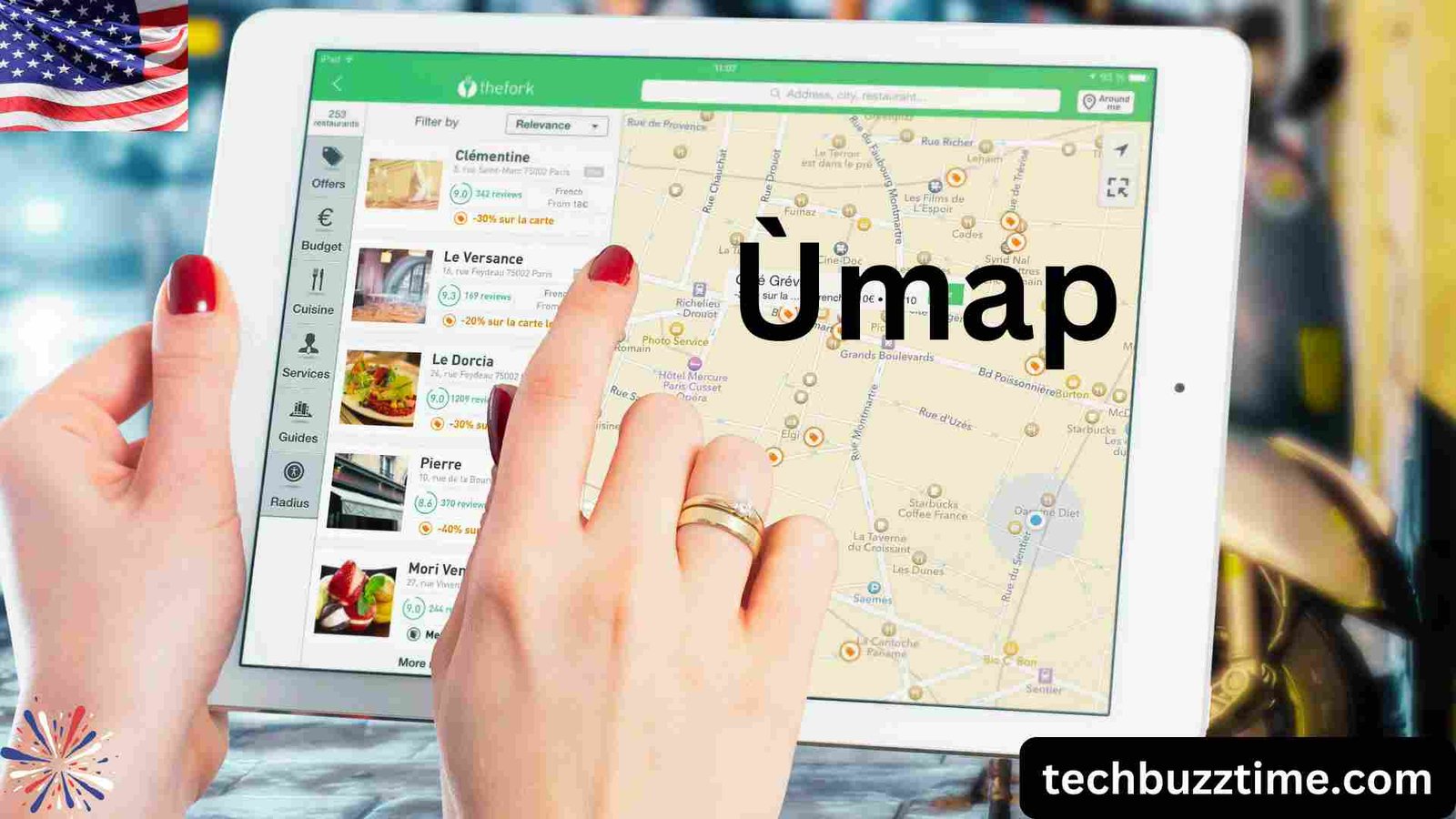Introduction
Users come across a section called Ùmap. This versatile tool can be used in various areas, including geography, information visualization, and even technological applications. This article dives deep into your one-stop shop for creating custom maps. This guide is your one-stop shop for learning all about ùmap! In plain English, we’ll explain its history. After exploring the core functionalities, let’s delve into the various types available to suit your specific needs. Capping it all off, we’ll unveil the neat features that are such a powerful tool.
What is Ùmap?
In simple terms, Umap acts as a platform to organize and visualize data. This tool works for all mappable information. This paper explores how improvements can be made in three areas: online maps, data organization, and interface design. These improvements aim to make it easier for people to find and understand complex information. This tool makes it easy to analyze data, design presentations, and even teach others. It does this by showing information in clear and simple visuals.
This Paper Focuses On Ùmap, Its History, And Its Development
The story of creating Ùmap is more like a journey through the domain of technology and successful innovations. With the development of various kinds of technologies, former practices of mapping information systematized visually expanded from Ùmap. Early on, Umap tools tackled basic geographic situations. As computers became more powerful, the features of Umap tools got better too. Modern maps burst with detail, revealing real-life features. They also let you zoom in and out and even tilt the view to see things from different angles. This change isn’t happening in isolation. New technologies and the growing use of data visualizations for decision-making are driving this trend.
Types of Ùmap
Úmaps come in several types. Each type is suited to different applications and objectives.
Geographical Maps: Geographical maps: beyond mountains & rivers. Visuals take it a step further, showing both geographic features and other quantitative data.
Data Visualization Ùmaps: These mass on conceptual representations of data – perfect for statistics, business intelligence, and research. They assist in the demonstration of trends, associations, and relationships.
Interactive Ùmaps: These special maps, called Umaps, let users work with data. Apps and websites often include this data to improve usability.
Educational Ùmaps: These maps, called Umaps, are designed to help people learn and teach. They make complex things easier to understand, like historical events, scientific theories, or economic ideas.
Advantages of Using Ùmap
Ùmap offers numerous advantages across various fields:
Enhanced Clarity and Insight: Many tools let you explore big data and maps. Ùmap offers a special advantage. It shows you everything in a clear, zoomed-out view. This saves you time and helps you make decisions faster.
Accessibility: This makes creating, sharing, and understanding complex information easy for everyone.
Customization: Ùmap lets users customize maps and how data is shown. This makes it useful for many real-world tasks, like research and business analysis.
Interactive Features: Many mapping tools, like those created with UMAP, allow you to zoom in and out and move around the map (panning). Clicking or tapping data points unlocks more information.
Integration Capabilities: Make sure to mention that Umap can be connected to other programs and interfaces. This widens the range of what Umap can be used for and makes it compatible with more systems. Search engines prioritize user-friendly content. Clicking or tapping data points unlocks more information.
Getting Started with Ùmap
For those new to Ùmap, getting started is straightforward:
Umap Tool: Choose the Right One for You: Consider goals before using Umap tools. Are you focusing on location data, showing information visually, or creating an interactive map? Choosing the right tool depends on these goals.
Learn the Basics: It is critical to get a general idea of how to use the tool. Most Ùmap platforms have a link to the tutorial or a get-started section for those who are new to it.
Gather Your Data: Ensure the data you want to present through visual or geographical display is ready. This can mean getting geographical coordinates, statistical data, or any other data that may be needed.
Start with a Simple Map: Begin by creating a basic map to get comfortable with Umap. Play around with different layouts and explore the available options to find the best fit for your data.
Ready to move on? Learn how to add more to your creations like pictures, videos, and even quizzes!
Easy-to-use interface and clear navigation make the program a breeze to explore
Several tools are developed keeping in mind the client satisfaction, thus, the provided interface is clear, simple, and comprehensible. Making the tool easy to use is key to its popularity. This way, both beginners and experts can achieve their goals without needing programming skills.
Catalyzing Travel and Tourism
Simple and clear: Forget vague maps! Ùmap offers the travel and tourism industry a powerful tool. Detailed, real-life maps of various areas ease travel for tourists, making their trip more enjoyable. Thanks to Ùmap, travel agencies, and tour operators prepare popular colorful, and informative brochures for the promotion of attractions and routes to help the visitors. Additionally, They can integrate real-time data like weather, traffic, and even ongoing events. This benefits tourists and business travelers in the travel industry.
Mastering Ùmap: A Prodigy’s Guide
For those looking to excel in using Ùmap, here are some advanced tips:
Deep Dive into Customization: See how you can go well beyond the basics of designing and formatting maps with layers and filter content and how your maps can look with different visualizations.
Leverage Plugins and Extensions: Many map creation tools can be customized to add powerful features, from built-in analysis tools to extra map layers.
Join Communities: Resume social networking and participate in online groups concerned with mapping applications. Finding things like bug fixes, cool user tricks, and creativity can be really helpful.
Continuous Learning: INFORMAT Individuals can learn about recent advances in technology. Some examples of knowledge acquisition are webinars that can contain useful tips and advice; workshops that introduce new approaches; and new releases of various programs that contain new methodologies as well.
Flexible Mapping Technologies
Úmap places this stretching capability in the context of flexibility within a specific problem and form of data. Switch between map views like topographic, satellite, or urban styles. Plus, overlay any data you want, from demographics and economics to environmental factors. It’s flexible as a multimedia database making it useful for various specialties in their tasks. This is because it offers aspects that cater to diverse needs.
Challenges in Mapping Technologies
While mapping technologies have undergone significant advancements, they continue to face challenges.
Data Privacy and Security: This is necessary given the fact that mapping tools like respectively process highly sensitive data.
Accuracy and Reliability: Accurate map data is crucial! This includes things like mountains, rivers, and other geographic features. Having the right information can make a big difference. Imagine rescuers using a map with the wrong locations – it could be dangerous! Good data is also important for city planning.
Technical Barriers: It’s quite intuitive as a standalone software, that to a degree comes with the territory of mastering just how to utilize all the complex functionalities associated with the more technical aspects of the product, making it perhaps not as appealing to newcomers to the application.
Satellite technology in the contemporary mapping process
Modern mapping relies on satellite technology. This system underpins many applications, including Ùmap. This has enabled high-resolution imagery. Additionally, real-time data collection. This one can provide accurate and timely maps essential for virtually anything from tracking the changes in climate to the development of cities.
Lessons Learned from Comparing Mapping Platforms
In the case of other mapping services, It’s often noted for customization options and a friendly user interface. Google Maps is popular for many reasons, and because of that, it offers a variety of helpful features for people. While GIS (Geographic Information Systems) also deals with maps and data, it offers much more. GIS includes advanced analysis tools, making it a powerful resource for scientific research and geographic exploration. Which platform is better depends a lot on its intended function, and knowing these strong and weak suits should help in making a decision on which platform to use.
Enhancing Urban Development Projects
The map helps to drastically improve the quality of optimistic urban development plans through the provision of accurate geographic information to planners and architects. Layering data like population density on traffic maps and public service availability allows cities to optimize land use, plan infrastructure effectively, and deliver more services. This ultimately leads to smarter and more sustainable urban environments.
Empowering Environmental Conservation
In the field of environmental conservation, It plays an important role in assessing, conserving, and most importantly, monitoring natural resources. Giving specific maps and more assists conservationists in monitoring the changes in ecosystems, measuring the effects that humans have on the planet, and implementing conservation strategies more strategically. Empowers tackling deforestation, monitoring wildlife, and observing water resources in a region. It provides the crucial insights needed for environmental action.
Can I use it for business?
It is a powerful tool with a wide range of applications across various industries. Retailers can leverage this to find ideal locations and analyze customer trends. Logistics companies can optimize delivery routes with assistance. In the real estate sector, They offer significant benefits. Empower agents to identify prime sales locations with valuable market trend data. This helps real estate businesses develop winning strategies. Ultimately, streamlines real estate business processes, making it an essential tool for success.
Most of the tools and platforms have their app counterparts
which offer similar functionality for smartphones and tablets. It is not a mystery that apps can contain such elements as GPS navigation, maps available for use offline, and additional options that would allow for easy navigation within the app and the data presented within it.
Future of Mapping Technology
Mapping technology is likely to see even greater integration with AI and machine learning. This will lead to the creation of new, possibly even predictive, map products. Real-time data is constantly improving in accuracy and availability. This paves the way for even better information and predictive power from future mapping technologies. These advancements will benefit urban planning, environmental control, business ventures, and more.
Conclusion
It makes mapmaking easy for everyone, from beginners to professionals. It transforms complex information into clear, engaging visuals. And as technology advances, capabilities will grow too, solidifying its place as a vital tool in our data-driven world.
FAQs
The most common Frequently Asked Questions about the Ùmap are given below:
Q: Even if an average user is unable to fulfill the requirements, is Ùmap still easy enough to navigate?
A: Yes, Ùmap is an inclusive service where the target users are provided with specific beginners’ guides and other tools to help them use it successfully with or without the help of other people.
Q: How safe is Ùmap to have sensitive data on it?
A: All the Ùmap platforms focus on the security of the data they provide and share and allow their users to set encryption and privacy levels.
Q: Can Ùmap work with other applications?
A: Yes, Ùmap can often be incorporated into other business/ or analytics software which improves its functionality and versatility.
Q: And what, if any, expenses are there related to the use of Ùmap?
A: Some Umap tools are free, while others have paid plans. These paid plans typically offer premium features or cover costs associated with using the tool.
Q: How do I begin with Ùmap?
A: Start by finding a Umap platform you like and creating an account. Once you’re set up, searching for tutorials or guidelines on data mapping becomes much easier.
Ideally, This detailed guide dives into the capabilities and significance of Ùmap. It even tackles frequently asked questions, making it a valuable resource for anyone looking to explore cutting-edge mapping tools.




Be First to Comment